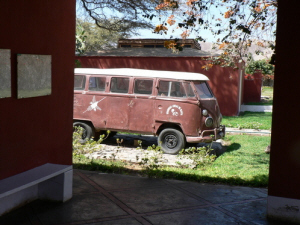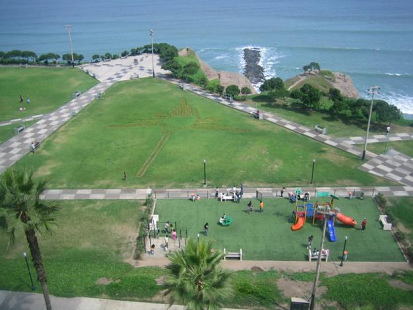from:
-- Aurelio Baltazar Muñoz Alarcón: "Después de María...
¿qué? En el centenario de su nacimiento" (in Engl..:
"After Maria... what will come?"); in collaboration with
Willy Rojas, Suhara Digital, Carlos Muñoz Alarcón; booklet
of Province Administration of Nasca in celebration of
100th anniversary of Maria Reiche 1903 2003. Thank you
Maria! purchased in Nasca in August 2009 in the library at
Main Square (Playa Mayor, Playa de Armas) of Nasca. Thanks
Maria!
-- Erich von Daeniken: Zeichen für die Ewigkeit. Die
Botschaft von Nazca (Engl.: Return of the Gods); Goldmann
Edition 1997
-- web sites.
Prehistory: Detection of the Nasca lines by the
Spanish colonists
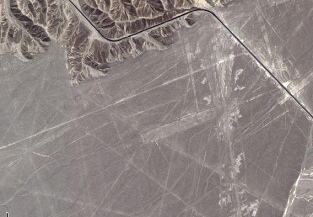
Satellite photo of a part of the Nasca lines with the road
of Southern Panamericana in the Nasca desert. One can see
only direct lines and runways. Later Mrs. Maria Reiche
also detected the figures.
The lines of Nasca are between km 419 and 465 of Southern
Panamericana, especially in the Plain of Jumana (in
reference to the village "Jumana") and in the Plain of San
José (in reference to the village "San José"), originally
called "Pampa de Jumana" and "Pampa de San José" (p.24).
Pampa de Jumana is the plain around Panamericana. Pampa de
San José is in the Ingenio valley [19].
1537: First detection of
the Nasca lines by the Spaniards: Pedro Cieza de León
Francisco Pizarro visited the region of Nasca (in Quechua:
Nanasca [19]), and Pedro Cieza de León saw the big earth
drawings (geoglyphs) and noted:
"Signs in a part of the desert surrounding Nanasca..., so
the Indians (natives) can detect their way they have to
follow." (p.22)
(orig. Span.: "Signos de alguna parte del desierto que
circunda a Nanasca..., para que los indios puedan encontrar
el camino que deben seguir." (p.22))
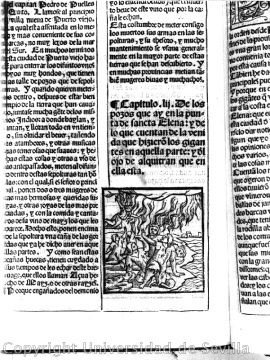

Pedro
Cieza de León, here is a print of one of his reports about
the "Indians" (natives),
noted about the Nasca lines as first European in 1537
Racist Spaniard Francisco Hernandez Giron noted:
"The Indians draw big lines in the soil." (p.23)
(orig. Span.: "Los indios trazaban grandes líneas en el
suelo." (p.23))
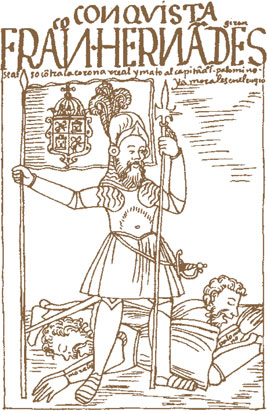
Racist Francisco Hernandez Giron on a title page of his
"colonial occupation" ("conquista"), mentioned the lines
of Nasca in 1554
Luis de Monzon noted the Nasca lines in 1586:
"Before the Spaniards and before the Inkas the Viracochas
were governing this region. The Indians followed their
advice and they built ways which can be seen today, long
ways like roads..." (p.23)
(orig. Span.: "Antes que los españoles dominaran a los
Incas, en tiempos antiquísimos llegaron los VIRACOCHAS a
estas tierras; los indios obedeciendo a sus sugerencias
hicieron caminos que hasta ahora se pueden ver, largos como
una calle..." (p.23))
1839: Notation by a public
servant Don José María Córdova and Urrutia
Don José María Córdova and Urrutia wrote about people which
have contacts with villages of the Hoya Geográfica del Río
Grande region:
"... In the neighbouring plains there are drawn many
drawings in different figures." (p.23)
(orig. Span.: "... En las llanuras inmediatas hay muchas
piedras dentistas que representan variedad de figuras."
(p.23))
1926: Toribio Mejia Xesspe
and Alfred Kroeber
Xesspe and Kroeber see at the "Calera" ["chalkstone"] lines
and trapezoids. Toribio Mejía Xesspe, a pupil of Tello, was
the first describing the lines in some detail (p.23).
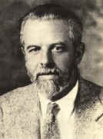
Alfred Kroebe, portrait
1939: Report from Xesspe at
Archaeological National Congress about lines of Nasca
(orig.: "Congreso Nacional de Arqueología") (p.23)
1939: Presentation at the
Americanist Congress
In 1939 Tello pupil Toribio Mejía Xesspe presented the Nasca
lines at 27th International Americanist Congress (p.23).
Maria Reiche
Birth in 1903 - studies in
Dresden
Maria Reiche (Victoria Maria Reiche-Grosse Newmann) was born
in Germany in Dresden (main town of Saxony) on 15 May 1903.
Her parents were Max Felix Reiche-Grosse and Anna Elizabeth
Newmann (p.7). Maria Reiche studied in Dresden at the
Technical University (two semesters in Hamburg and Leipzig)
[2] and at the university. When she developed more and more
knowledge in mathematics she was fascinated from precise
working and from truth expressed by the figures. She
finished her studies in maths, geography, physics and
pedagogy (p.8) and philosophy [2]. With this she had passed
her higher teacher's training certificate [9].
Maria Reiche also played well the piano and the flute
(p.13).
1919-1932: Hamburg
In 1929 Maria Reiche got a job in Hamburg [2] but never got
more than assistance jobs [9] By economical crisis [6] and
by uprising national socialism [9] she found that a stay
abroad would be good for her and applied for a job as
private tutor in Cusco. She was elected from 80 applicants
and undertook the trip from Hamburg to Lima [9].
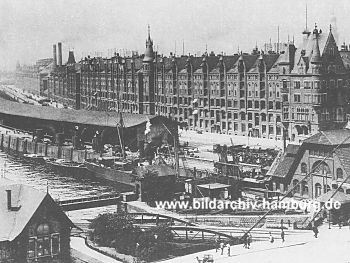
Hamburg, the freeport in the 1920s (web site
www.bildarchiv-hamburg.de) |
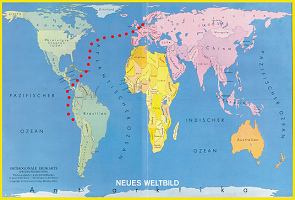
World map with the trip from Hamburg to Lima (port
Callao)
|
During the trip the ship passed some rain bows following one
another [7,22]. This natural spectacle made a big impression
on Maria Reiche [7].
since 1932: Cusco
Mrs. Reiche was traveling to Cusco in 1932 for a
German-Peruvian family of Mr. Tabel (German consul and head
of a brewery) to educate their children as a private tutor
(p.7).
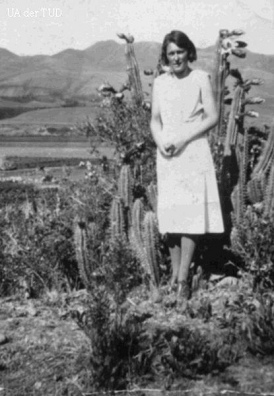
Maria Reiche in Cusco with a tuna cactus aside
When Maria Reiche came to Peru and established in Cusco she
could not one single word of Spanish. By a certain need she
purchased her first book "Korichampi" (transl. "Golden Age")
from young Lisandro Caller. He was the father of Maria's
girlfriend Clorinda Caller Iberico (p.7).
In Cusco she also made many walks, and one time she got a
spine into her middle finger of the right hand which
developed that unfortunately that the finger had to be
amputated (p.12).
Maria Reiche stayed two years in Cusco [10]. She was
occupied a lot with cultural heredity of Peru with the Inkas
as diary notations prove [29].
1934? Trip to Lima
Maria traveled by train from Cusco to Arequipa where she
bought a ticket for a ship from Mollendo to Lima. In the
ship the German consul said that Maria Reiche was forbidden
to leave the ship in Lima, but she had to return directly to
Germany to Hamburg (p.8).
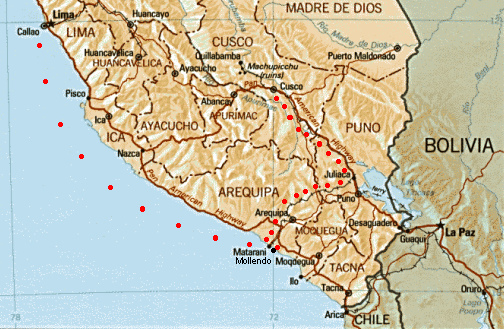
Map of the trip of Maria Reiche from Cusco over Arequipa
to Mollendo by train, and then from Mollendo to the port
of Callao near Lima by ship
Maria never wanted to return back to Germany (p.8), and at
this time it was a Nazi Germany [6]. On the ship she got to
know a young woman who had a kindergarten project in Peru
where the children should learn English. The new friend was
the daughter of a member at the Court of Lima. Maria offered
her collaboration but also told about her circumstances of
her trip and had to indicate that she could not stay in
Lima. The relation to the family of this young lady
contributed that the circumstances cleared up (p.8) and
Maria Reiche could stay in Peru [6].
One day the kindergarten was shut and Maria began to work as
a translator and as a language teacher (p.9). She worked at
the German School at Miraflores (orig.: "Colegio Alemán de
Miraflores") (p.14). One of the pupils was Amy Meredith, and
there developed a strong friendship, "as if two persons
wanted to go together over all mountains and wanted to find
out all what exists on the world" (orig.: "como una unión de
dos montañas empeñadas en sobrepasar todas las cumbres,
viendo y buscando siempre más allá"). Amy became Maria' best
girlfriend (p.9).
Maria Reiche gave German and English lessons, also
gymnastics and massages [10].
At the beginning Spanish of Maria Reiche had a very
"teutonic" accent using f.e. only the basic forms of the
verbs etc. [5] and it can be that this was irritating the
Peruvian partners first. But then as a translator in Lima it
can be sure that she spoke a goos Spanish [6]. But also
sneering Peruvian newspaper articles after her death called
her a "gringa" yet and allege her a Spanish of her first
times, f.e. the article of the daily paper of Nasca
"Cronista de Nasca" from 12 January 2008: Una gringa en
Nasca: María Reiche (Engl.: "A Gringa In Nasca: Maria
Reiche") [5]. But racism and mockery against foreigners has
a big tradition in Peru, and the Peruvians mean yet they
would be "intelligent" making these bad jokes. But Peruvians
never will be more intelligent with their traditional racism
and mockery... [6]
![Maria Reiche in the 1930s about in Peru,
portrait. Her shortsightedness was detected only in
Peru, and since then she was wearer of glasses [7]. Maria Reiche in the 1930s about in
Peru, portrait. Her shortsightedness was detected only
in Peru, and since then she was wearer of glasses [7].](d/Munoz_Reiche-d/13-Maria-Reiche-1930s-apr-retrato.jpg)
Maria Reiche in the 1930s about in Peru, portrait. Her
shortsightedness was detected only in Peru,
and since then she was wearer of glasses [7].
In 1937 Maria Reiche became member of National
Anthropological National Museum [in Lima], as translator and
as
|
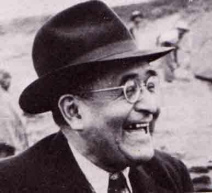
Julio C. Tello, for him Maria Reiche made
translations
|
|
assistant of Doctor Julio C. Tello, the museum's director
(p.9). In a tee saloon of her girlfriend Amy Meredith
at Olaya lane (orig.: "Pasaje Olaya") in Lima (p.8) Maria
Reiche was working as an accountant (p.9). This café was not
a normal café but a favorite meeting point for professors,
students, managers and foreigners [10].
Translation work - Clorinda
Caller Iberico - Dr. Tello - orphan Esparte with singing
talent
In 1940 in National University of San Marcos [in Lima] Maria
Reiche got to know Clorinda Caller Iberico. Maria Reiche was
making translations from German and from English for the
professorship of anthropology. Doctor Julio C.Tello and
Clorinda Caller Iberico dictated the text, and she
translated it an put it down on type writer. Clorinda Caller
Iberico was one of the few real girlfriends of Maria in Peru
(p.9). With Clorinda Caller was living an orphan from the
jungle, Esparta. Clorinda was like a mother for her. Maria
Reiche teached her reading and writing and detected a
splendid hereditary singing talent and brought her to
Germany later (p.15).
Besides Maria Reiche played in an excellent manner classical
music on the piano and on the flute and developed also an
activity as a music critic (p.13), and in the Archeologic
Museum of Lima ("Museo de Arqueología") she prepared burial
shrouds of mummies [10].
1938: Construction of
Panamericana - partition of the soil drawing of the lizard
In 1938 the Southern Panamerican highway "Panamericana" was
built, and building it the soil drawing of the lizard was
parted. Before the construction of Panamericana the
population was passing the drawings arbitrary, and the
population never saw one single figure... [7]
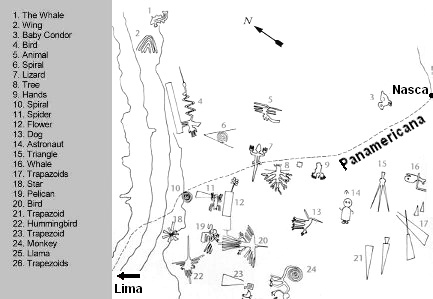
|
Map of the main figures of Nasca with
the Panamericana parting the lizard (figure no.7)
The other figures are almost all wrong in the map
because they are not turned with the compass
rose,and the tree (figure no.8) has it's crown to
the contrary direction, see the analysis of the
maps of the Nasca figures.
|
1939: Dr. Paul Kosok
investigating old irrigation systems in Peru - Kosok at
the tracks of the aqueducts of Nasca - Kosok detecting
also the lines around Nasca
In 1939 the "American" history professor Dr. Paul Kosok from
Long Island University came to Nasca. His specialty were old
irrigation systems which he had studied in this year
already in Northern Peru. Some scientists before him had
detected the aqueducts and this he wanted to
verify here. But he noted that the soil was much too
permeable and water channels were impossible here he
thought. During his work he also detected Nasca figures,
f.e. a bird, or a star. And by chance he took a photo of a
line on 21 June 1939 which correlated with the solstice. But
the mission of Kosok in Peru should end soon, so he was
looking for a research assistant who would go on with his
work with the Nasca lines [7].
1941: Professor Paul Kosok
looking for a translator and an assistant for the Nasca
lines - meeting in the café
Maria Reiche got to know Professor Paul Kosok. Paul Kosok -
a singular person and attracted by the beautiful location of
the tee saloon of Amy Meredith (p.8) was talking a long time
with Amy looking for a woman who was English speaking and
was good in maths (p.9) for a translation of his articles
about the Nasca lines from English into Spanish [10]. Then
Maria Reiche entered the saloon - she was doing the
accounting by friendship there. Amy Meredith called her and
presented her Mr. Kosok (p.9). Kosok also spoke about the
strange, dead straight lines and to show them to her. Kosok
presumed that there was an astronomic calendar [10]. And
soon after their first meeting they were together in the
Nasca plain in a plain of aerial photo service (orig.:
"Servicio Aerofotográfico") (p.9).
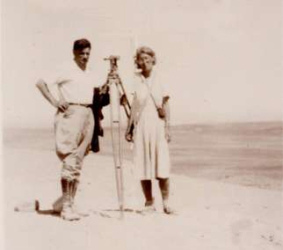
Maria Reiche with Paul Kosok measuring lines of
Nasca, 1940s
|
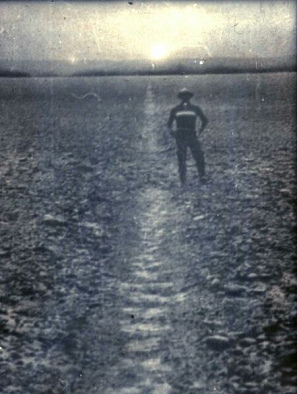
Paul Kosok at a line pointing to sunrise at
solstice, 1940s
|
Maria Reiche agreed to the research mandate and by this
became Kosok's research assistant [7]. Maria Reiche
translated the article of Dr. Kosok from English into
Spanish [29]. With her assistant job with Dr. Kosok she
converted from a teacher and translator to a woman
archaeologist [17], an epoch-making woman archaeologist and
desert cartographer [6].

Satellite photo of a part of the Nasca lines with the road
of Southern Panamericana in the Nasca desert. In this hot
desert Maria Reiche was living the rest of her life to
measure the lines
The first time Maria Reiche was working in Nasca on 17
December 1941 to record solstice in the Nasca desert for
Professor Paul Kosok (p.10). She took a night in the Nasca
Hotel "Royal", today at the third block of Lima square
(orig.: "Calle Lima"). (p.11)
A truck, a ladder and
measuring instruments - first only the lines were measured
Maria Reiche made her first photos with a borrowed ladder of
the electricity company and a rented truck [29]. First Maria
Reiche took the big lines and measured them with a ladder, a
measuring tape, a sextant and with a compass to link
the lines together with astronomic facts. Besides were
detected also the figures which were measured only when her
eyesight was going down [11].
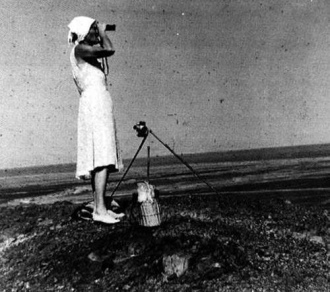
First Maria Reiche measured the lines in the
desert plain, with camera, measuring band, sextant
and compass.
|
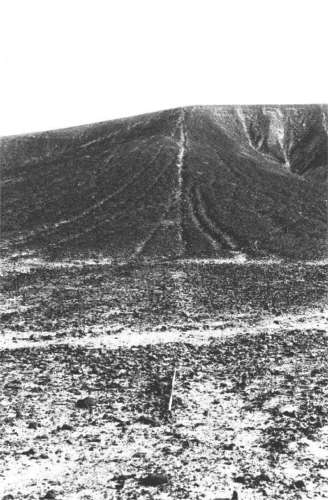
Some lines headed directly on the steep hills
|
1942: Big earthquake in
Nasca
[5]; it can be admitted that after the big earthquake the
population had other things in their heads than to see lines
in a desert or to think about the generation of these lines,
and that's also why there was hardly any enthusiasm in the
population for the lines [6].
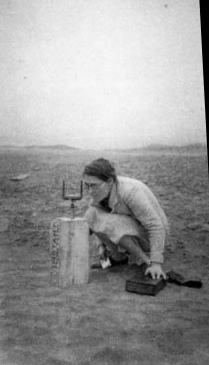
Maria Reiche in 1942 at measuring work in
Pachacamac near Lima
|
x
|
Line of solstice
(21 December) with cane and hat from Maria
Reiche. To put cane and hat was one of her
working methods of her measuring work.
|
xxxxxxxxxxxxxxxxxxxxxxxxxxxxxxxxxxxxxxxxxxxxxxxxxxxxx
|
|
|
12 February 1945: Entry
into the war of Peru and interruption of Nasca work
Peru entered the war on 12 February 1945 on the side of the
allies [8], and by this all Germans - also Maria Reiche -
only was permitted to stay in Lima. This was a break of work
in Nasca of some months [7].
since 1946: full time in
Nasca - finances and help
Since 1946 Maria Reiche was only busy with the geoglyphs,
one can say as a full time job (p.12). She began her
lifework, mapping of the holy figures in the plain of Nasca
[7]. The first figure she detected was the spider in June
1946 (p.12). She found the spider and sent photos to Dr.
Kosok. He brought the photos in different magazines
copyrighted but did not respond any more. She sent another
letter to Dr. Kosok telling that the whole plane was full of
figures. But Dr. Kosok another time did not respond. So
Maria Reiche borrowed money and established in Nasca to
measure systematically the lines and the figures [29].
According to Maria Reiche the only person who helped her was
the mayer of Nasca and future deputy, Don Agustín Bocanegra
y Prada who provided a garbage lorry and a ladder (p.17).
With the garbage lorry Maria Reiche was driving daily to the
Pampa before sunrise [11] to make the first photos of the
plain (p.17). When it was clear that it was more intelligent
to have lodging nearer to the lines she could establish
herself at the Panamericana, at "Centro Poblado La Pascana"
in San Pablo hamlet in El Ingenio district at km 417 of
Southern Panamericana (orig.: "Panamericana Sur"). There the
German scientist was living in a little house for her work
and her research, 27 km from Nasca (p.11).
In the same year of 1946 Maria Reiche detected more marks,
lines and triangles which had a link with solstice, and
especially there were lines linked with the moon's
positions.
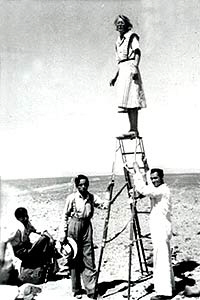
Maria Reiche in 1946 on a ladder
In 1947 and 1948 she got scholarships for the research in
the plane of Nasca ("Pampa de Nasca") from the Higher
National University of San Marcos, all in all 2500 Soles.
Clorinda Caller Iberico applied for the scholarship at Dr.
Miguel Noriega del Aguila, high school professor at the
Chemistry Faculty of the University. He approved the
scholarship for his friend Maria Reiche (p.12).
At the same time the activities of classical music stopped,
but the gods of Nasca had deplored her absence because only
by Maria Reiche the figures of Nasca got world-famous
(p.13).
The work of Maria Reiche in the plane of Nasca was supported
by further persons and institutions:
-- Professor Paul Kosok
-- Amy Meredith
-- Clorinda Caller Iberico
-- Andrea Murguía Sender and family
-- Schoroth and Kanmacher
-- Agustín Bocanegra and Prada
-- Ing. Del Solar (Nasca - El Ingenio)
-- Higher University of San Marcos, Institute for Higher
Studies
-- National Service for Aero Photos (orig.: "Servicio
Aerofotográfico Nacional")
-- Booster Club for Reconstruction of Ica (orig.: "La
Corporación de Reconstrucción y Fomento de Ica")
-- Lufthansa, at Kurt Zalud von Lima
-- Eva Pehlemann
-- Margarethe Scheweizer [Schweizer?] from Stuttgart
-- and all the drivers who had taken her with them to the
Pampa (p.14).
1947 about? First aerial
photos taken from a little airplane
Maria Reiche made their first aerial photos from Ingenio and
Nasca with the help of the engineer Del Solar who was taking
her over the Pampa. He was a pilot of little airplanes who
were normally sprinkling over agricultural fields (p.17).
Detection of the flamingo
figure with solstice link
When Maria Reiche saw the figure of the flamingo
(span.: Flamenco,
Parihuana) - which is 300 m long - she initially had the
idea that there would be a link with solstice. In the
morning of 20 to 23 June [there is no year indicated] she
got aware that sun rise is coordinated with the beak and
with the top of the hill behind. She meant that this would
be the Sun's birth at the Inti Raymi festival (p.16).
Since 1947 Maria Reiche worked also with a theodolite as a
measuring instrument [29].
1948: The first work
[In 1949] Maria Reiche was writing her first booklet in
Spanish: "Los Dibujos Gigantescos en el suelo de las Pampas
de Nasca y Palpa. Descripción y ensayo de interpretación",
then also in English "Mystery On The Desert - a New
Revelation Of Ancient Peru" (p.15).
At the same time the Peruvians also wrote many stories about
Maria Reiche (p.14).
1952: Detection of the
monkey
[28]; for this figure of the monkey Maria Reiche had a
certain preference because he only had 9 fingers as she had.
It's sure that there would be something mystic or another
enigma behind (p.12).
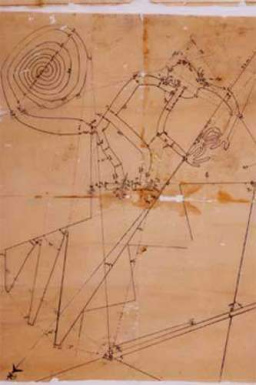
Maria Reiche, her drawing of the monkey with lines
in form of saw tooth zigzag lines
|
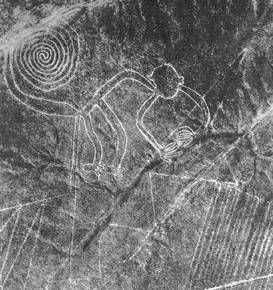
The geoglyph of
the monkey, the sight from above on the figure
cleaned by Mrs. Reiche. The monkey has nine
fingers and is surrounded by zigzag lines in
form of saw tooth zigzag lines and parallel
zigzag lines covering surfaces.
|
1954: Great photos of the
Nasca lines from skid of a helicopter
With 52 years Maria Reiche let fix herself on a skid of a
helicopter outside of the cockpit to make big aerial photos
of the giant figures. Her big photos made her world-famous
[1,28].
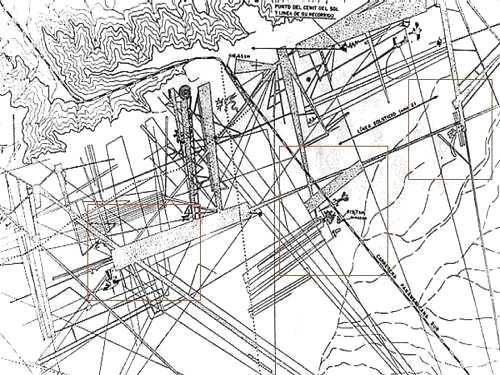
A part of a map of the Nasca plane basing on a map of
Maria Reiche
During the first time Maria Reiche was helped in
photographing and was helped to hinder the irrigation
project for the desert (p.17). [The project was to convert
the desert into an agricultural zone and to destroy all the
geoglyphs].
<In 1955 a rich big landowner wanted to install a cotton
plantation on the plain. There should be a big irrigation
system. When Maria Reiche saw the first measuring poles on
the plane she began her fight against bureaucracy. She went
from one office to the other, from one newspaper to the
other, organized expositions in Lima with her photos and
drawings from the figures and from the lines.
Characteristic for the practice to present the women's
working results is the article of "La Cronica" from 8
September 1955. There could be read: "One single woman wants
to find out the mysteries of a 20,000 ha calendar, the
world's greatest calendar? - Impossible! This is the work of
a whole group of scientists, and this means hardship without
limits in the desert."> [30]
(orig. German:
<1955 wollte ein reicher Grossgrundbesitzer auf der Pampa
eine Baumwollplantage anlegen. Ein grossartiges
Bewässerungssystem sollte gebaut werden. Als Maria Reiche
die ersten Vermessungspfähle auf der Pampa vorfand, begann
ihr Kampf gegen die Bürokratie. Sie lief von einer Behörde
zur anderen, von einer Zeitung zur nächsten, organisierte in
Lima eine Ausstellung mit Fotos und Zeichnungen von den
Figuren und Linien.
Bezeichnend für den Umgang mit den Arbeitsergebnissen von
Frauen ist der am 8. September 1955 gedruckte Artikel in der
"La Cronica". Darin stand zu lesen: "Eine Frau allein soll
den 20 000 ha des grössten Kalenders der Welt ihre
Geheimnisse entreissen? - Unmöglich! Das ist das Werk einer
ganzen Gruppe von Wissenschaftlern und das bedeutet
Entbehrungen ohne Zahl in der Wüste."> [30])
[Supplement: The aqueducts
already were there
It seems strange that the men of power of Nasca did hardly
help to Maria Reiche. It can be admitted that certain
agricultural interest to irrigate the desert of Nasca and to
sell agricultural products was coming up again and again
[6], above all because the Nasca plain already had a water
supply by aqueducts [7], and because the neighbouring valley
of Ingenio already was irrigated. The lines did not mean
anything to the capitalist mafia, and it seems the mafia did
not know that in Ingenio valley some lines already were
destroyed. These destroyed geoglyphs of Ingenio are coming
up again when the soil is dry untreated [4: Däniken, p.55].
All in all one can admit that in Ingenio valley about 20
further figures were destroyed before Maria Reiche began her
work in Nasca. At least the soil drawings of Nasca were
protected, so [6].
Session in Congress for the
Nasca lines - mayor of Nasca stops the irrigation project
for the Pampa
Mayor Bocanegra de Nasca called for a session in Congress of
the Republic so Maria got the occasion to show 800 photos
with the lines and figures of the Pampa. So she could also
convince them that they were important also for the future
of Peruvian and above all for local tourism. Since this time
every irrigation project was blocked. The time gave her
right, to the "Lady of the Plain ("
orig.: "Dama de las Pampas") (p.17). She had
won the fight against bureaucracy [13].
The dimension of the lines,
quadrangles and figures
On a surface of 50 kilometers length and 5 to 7 kilometers
width between the foot of the Andes and the Sea there are
spread:
-- thousands of straight lines
-- hundreds of triangles and quadrangles
-- dozens of figures.
<The number of drawings on the Pampa is immense. There
are thousands of straight lines, hundreds of triangles and
quadrangles, and dozens of figures. All this spread over 50
kilometers from north to south, and 5 to 7 kilometers from
the foot of the Andes toward the sea. The biggest
concentration of drawings is always found at the edges of
the different plains where the descent to the valleys begin
[...] On the other hand there are some very isolated
drawings in the midst of the desert. Others are on high
mountain tops or behind mountain ridges> [7]
<There are figures only 4 meters long and others with a
length of 200 to 300 meters. The same applies to geometric
surfaces. There are some that are only a few meters long;
the longest quadrangle further north has a length of 1,600
meters. The sizes come in several categories. The next
category begins with a line that is 800 meters long. That's
the length of the lines next to the spider and heron. There
is another one half that size, a little over 400 meters. It
is the quadrangle next to the lizard.> [7]
<The length of the straight lines also varies. I know two
that are 9 kilometers in length and absolutely straight.>
[7]
Maria Reiche about the
quadrangles and the positions of the Sun and the moon
<For instance, the big quadrangle beside the figure of
the spider is a moon direction and the other one beside the
figure of the Heron with the winding neck, is one side in
the single direction and the other side in the solstice
direction! Such a quadrangle could have served to predict
eclipses, which were a powerful means of subjecting the
people. Even Columbus used an eclipse to frighten the people
as he knew the correct time to do so.> [7]
Maria Reiche cleaning the
lines with a broom from gravel and dust of clay
"From the air the figures were not visible either due to the
nature of the soil at the time. You see the figures are of a
whitish color on a brown surface, this brown surface is a
thin covering of dark stone about 10 cm, which suffers the
process of oxidation giving the entire region its particular
brownish effect. Underneath the soil is still whitish, not
brown, comprised of a mixture of rock that had been split
into small fragments due to extreme temperatures, and clay,
which ultimately was blown away by strong winds coming down
from the Andes. The huge basin was filled with this mixture
creating this flat surface we call the Pampa. This is why we
only have these small pebbles on the surface.
The figures, the drawings, are very superficial furrows
never more then 30 cm in depth, and very shallow. For this
reason the wind has obscured them by filling them with small
dark pebbles from the surrounding surface like grain, making
them difficult to detect from the air. To make them more
accessible for viewing I cleaned them with a broom, one
broom after another throughout the years. I went through so
many brooms rumors circulated that I might be a witch!" [7]
At the beginning the population was laughing at the women
who is "cleaning the desert" [13] resp. about the "woman
with the broom" [15].
![Maria Reiche in the 1960s
with a Volkswagen (VW Beatle) and broom to clean
the lines. The old Volkswagen was bought by
sister Renate for Maria [18]. Maria Reiche in the 1960s with a Volkswagen
(VW Beatle) and broom to clean the lines. The
old Volkswagen was bought by sister Renate for
Maria [18].](d/Munoz_Reiche-d/23-Maria-Reiche-1960s-c-volkswagen-en-desierto.jpg)
Maria Reiche in the 1960s with a Volkswagen (VW
Beatle) and broom to clean the lines. The old
Volkswagen was bought by sister Renate for Maria
[18].
|
|
Maria Reiche
(here about in the 1980s) cleaned the drawings
around Nasca with a broom so the world could see
the drawings better
|
x
|
A part of the
drawing of the flamingo (also called arum, heron
or Phoenix bird): Mrs. Reiche cleaned all the
lines so they were well visible for world public
|
xxxxxxxxxxxxxxxxxxxxxxxxxxxxxxxxxxxxxxxxxxxxx
|
|
xxxxxxxxxxxxxxxxxxxxxxxxxxxxxxxxxxxxxxxxxxxxx |
So Mrs. Maria Reiche worked as a "cleaning woman" for years,
and by this she is the most famous cleaning woman of the
world, and we thank her for this absolutely troublesome work
with the broom performed for years in the boiling heat of
the Nasca desert. At the same time there is the
question why Mrs. Maria Reiche could not install a team
helping her in this work, but it seems she did all alone
because the machos of Peru did not help her, and because
Nasca was in ruins since the earthquake of 1942 - the
population was busy with it's own existence, but not all!
[6]
Maria Reiche about the
lines in sand storms and the contamination of an iron mine
<There are extremely strong winds here, even sandstorms,
but the sand never deposits over the drawings. On the
contrary, the wind has a cleansing effect taking away all
the loose material. This way the drawings were preserved for
thousands of years. It is also one of the driest places on
earth, drier then the Sahara. It rains only half an hour
every two years! Now all this has changed due to air
pollution. Huge masses of dust and sand blow in from a large
iron mine southwest of Nasca and fill the entire region with
contamination, this produces precipitation, not enough for
agriculture, but enough to endanger the figures.> [7]
1957: The first report
abroad about Maria Reiche's work by J. Alden Mason
The first studied foreigner mentioning Maria Reiche's work
was [John] Alden Mason in 1957 with his book "The Ancient
Civilizations of Peru" (S.12).
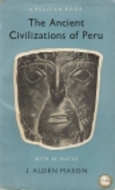
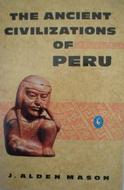
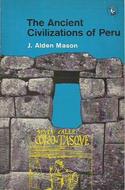
J. Alden Mason's book "The Ancient Civilizations
of Peru" mentioning Maria Reiche's work, some
different covers
|
1960s? Death of girlfriend
Amy Meredith
Amy Meredith suffered cancer, and after an operation science
had no other explanation than cancer was incurable. Meredith
fought for her life as she could traveling to Northern Peru
to find a hope. Two weeks later she returned and had given
up all hope. Three months later she was buried and Maria
Reiche fulfilled her last wish at the funeral presenting Amy
Meredith's message: "Dear friends, there was a trip without
return; not one single second of my life I regret my ideas
or was anxious of death; I will grow on and on, so the end
of the humans will be the human itself" (orig.:
"Queridos amigos, emprendió el viaje sin retorno; ni en un
segundo de mi vida me arrepentí de mis ideas, ni tuve miedo
a la muerte; sigo creyendo que el fin del hombre está en el
mismo hombre.") (p.13).
The death of girlfriend Amy Meredith left a big void in
Maria Reiche's life (p.9). For some time there was no work
in the Nasca desert (p.13).
1960s: Maria Reiche's life
is going on to be in a spartan lifestyle
<Up to the 1960s of the 20th century Maria Reiche had
measured a territory of about 150 square kilometer by foot.
She continued with her spartan lifestyle in a little hut at
the margin of the Pampa Colorada.> [1]
(orig. German:
<Bis in die 60er Jahre des 20. Jahrhunderts hatte Maria
Reiche ein Gebiet von rund 150 Quadratkilometern zu Fuss
vermessen. Dabei lebte sie spartanisch in einer kleinen
Hütte am Rande der Pampa Colorada.> [1])
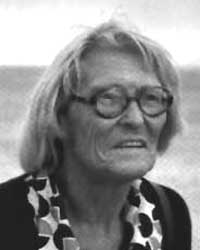
Maria Reiche, portrait of the 1960s about
|
![Maria Reiche about in the
1960s measuring a line here. This photo became
world-famous and changed the awareness of the
world [15] Maria Reiche about
in the 1960s measuring a line here. This photo
became world-famous and changed the awareness of
the world [15]](d/Munoz_Reiche-d/28-Maria-Reiche-1960s-apr-midiendo-Linea.jpg)
Maria Reiche about in the 1960s measuring a line
here. This photo became world-famous and changed
the awareness of the world [15]
|
1960-1964: Collaboration
with Yonah from New York - introduction of a card index
system for the lines
<In 1960 Maria Reiche met 21 year old Jew Yonah Ib'n
A'haron. He lived in the "USA" and had studied Torah and
had found a committee for the protection of the Nasca
lines in New York. Between 1962 and 1964 he helped on the
Pampa. He had many good ideas for Reiche's work, for example
he developed a card index system for the lines with
indication of their metering points and characteristics.>
[1]
(orig. German:
<1960 traf Maria Reiche den 21-jährigen Juden Yonah lb‘n
A’haron. Er lebte in den USA und hatte Thora-Theologie
studiert und in New York ein Komitee zum Schutz der
Nasca-Linien gegründet. Zwischen 1962 und 1964 half er auf
der Pampa. Er brachte zahllose gute Ideen in Reiches Arbeit
ein, unter anderem entwickelte er ein Karteisystem, in das
die Linien mit ihren Messpunkten und Eigenarten eingetragen
wurden.> [1])
1964-1965: Maria Reiche as
language teacher in the country
Now Maria Reiche also was working as elementary school
teacher against analphabetism at San Cosme Mountain of Lima
(orig.: "Cerro de San Cosme de Lima") (p.14). In 1965 she
was teaching in Ayacucho in Moya and Quinua where their work
was taken over by a person who had learnt reading and
writing by her (p.14-15). With this Maria Reiche could make
some money for further work in Nasca [30].
1965-1968: Installation of
a booster club for reconstruction
(orig.: "La Corporación de Reconstrucción y Fomento de
Ica"); in this organization the members realized the value
of Maria Reiche's work. The persons also realized that this
region would be a future tourism zone with positive
consequences for economy. They decided to encourage Maria
Reiche to write a book about the Nasca lines and drawings,
and the club would publish the book in German. They payed
the trip and the expenses for the edition (p.24).
1967: Lecture of Maria
Reiche at London University for the Nasca Lines
With this lecture Maria Reiche could reach that the
destruction of the desert drawings was blocked (p.15).
since 1967: Correspondence
with Clorinda
In 1967 Maria Reiche began a correspondence with Clorinda
Caller Iberico in Lima (p.15).
1968: Book of Maria Reiche
"Mystery on the desert"
The book of Maria Reiche is edited in German, English and
Spanish and is a big success [13], in German "Geheimnis der
Wüste" [14], in Spanisch "Secreto de la pampa" (p.14).
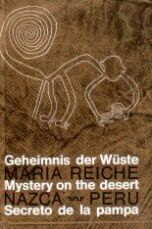
Maria Reiche's book "Mystery on the desert" of 1968 (here
the cover) was edited just in three world languages
Now there followed participations at congresses and lecture
tours. From now on also the tourists were a danger for the
plain because they were driving with their vehicles through
the Pampa [30].
1970: Maria Reiche at the
Americanist Congress
Maria Reiche applied in vain for an international protection
of the lines of the Nasca region. Her request was not
followed and curious people were going on marching and
driving on the lines [13].
1972: Thoughts about her
work in the Pampa: Only after her death will be accepted
In 1972 Maria Reiche said about her work:
<At the end I am on the safe way, but this process is
going on only slowly, and I don't take fright the trouble. I
don't expect either that one understands me or that one
accept my results (p.15). It's enough for me to know the
truth for myself, and then I will die and then the people
perhaps will accept.> (p.15-16)
(span.: <Al fin estoy en camino seguro, aunque el proceso
es lento y trabajoso, no espero que me entiendan o acepten
mis resultados, a mí me (p.15) basta saber la verdad y
después de morir ya lo aceptarán probablemente.> (p.16))
About the Peruvians who are writing stories about her, she
said:
<I will never loose my time with the lots of stories they
write about my person. This is not important. The Nasca
drawings which are destroyed by many people and on
which people is marching on, they are important.> (p.14)
(span.: <Jamás voy perder mi tiempo leyendo las muchas
historias que han escrito sobre mi. Eso no importa. Lo que
importa son las figuras de Nasca que son destruidos hasta
hoy por la mucha gente que marchan sobre las figuras.>
(p.14))
since 1973: Eva Pehlemann
spreading the wisdom about Nasca in Europe
Since 1973 the German friend Eva Pehlemann supports the
spread of Maria Reiche's work and research in the Nasca
plain (p.17).
1974: Exhibition in Munich
Maria Reiche can perform her first great exhibition about
the Nasca Lines, with the title "Peruvian soil drawings"
(orig. German.: "Peruanische Erdzeichen") [28].
28 November 1975: First
hot-air balloon over the Nasca plain
On 28 November 1975 the two scientists Julian Nott and Jim
Woodman from Florida succeeded with a flight with a
hot-air balloon "Condor I" to get an overall sight of the
Nasca plain (p.22).
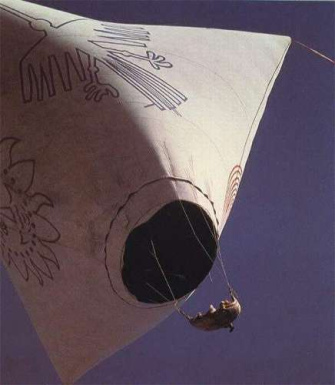
Hot-air balloon ("Condor I" at 28 November 1975
According to Erich von Daeniken the balloon experiment was
not a success. He indicates that the basket turned over and
the two balloonists fell, and the balloon was flying alone
some kilometers [4: Daeniken, p.127]. According to other
sources the balloon made a distance of 3 km and a height of
350 m [16].
This balloon experiment was the start for tourist
commercialization of the lines of Nasca in the plains of
Jumana and San José (p.22). When tourism was starting in
fact, Maria Reiche converted into a holy person for the
region [13].
1976: Viewing tower
With the viewing tower at km 420 of Southern Panamericana, 3
km from the little house of Maria Reiche in the hamlet of
San Pablo (km 417) [21] should be hindered that curious
people were marching on on the lines or destroying them by
driving [13]. The tower was financed by the Murguia family,
especially by Andrea Murguia Sender, and some other friends
who before had run semigovernmental organization
"Pescaperu". The metal viewing tower was a present to
Maria Reiche (p.13).
|
|
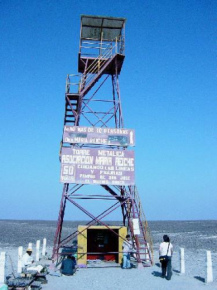
|
 The
viewing
tower in the Nasca plain was financed by a
team of Maria Reiche and constructed in 1976.
The shield of the tower indicates that there
should not be more than 10 persons on the
tower.
![Der
Aussichtsturm hat sogar eine Ortstafel
bekommen [24], denn scheinbar ist der Turm so
unscheinbar, dass viele daran vorbeigefahren
sind [6]. Der Aussichtsturm hat sogar eine
Ortstafel bekommen [24], denn scheinbar ist
der Turm so unscheinbar, dass viele daran
vorbeigefahren sind [6].](d/Munoz_Reiche-d/34-mirador-metalico-c-placa-mirador.jpg)
The viewing
tower even got a place-name sign [24] because -
as it seems - some had passed the tower without
seeing it [6].
|
View from the viewing tower on the Nasca plain
with it's Nasca lines
|
![The
viewing tower is located just aside the drawings of the
lizard, the tree, and the hands (with 9 fingers as the
monkey). There can be seen on the photo that the lizard
was parted by the Panamericana at the begin of it's
tail. The wheel tracks of "wild visitors" in
the background have already caused considerable damage
[25]. The viewing tower is located just
aside the drawings of the lizard, the tree, and the
hands (with 9 fingers as the monkey). There can be seen
on the photo that the lizard was parted by the
Panamericana at the begin of it's tail. The wheel tracks
of "wild visitors" in the background have
already caused considerable damage [25].](d/Munoz_Reiche-d/36-mirador-metalico-c-pintados-Lagarto-arbol-manos.jpg)
The viewing tower is located just aside the drawings of
the lizard, the tree, and the hands (with 9 fingers as the
monkey). There can be seen on the photo that the lizard
was parted by the Panamericana at the begin of it's tail.
The wheel tracks of "wild visitors" in the background have
already caused considerable damage [25].
When the viewing tower was completed, Maria Reiche said:
<At last the viewing tower is ready. Now only a security
is needed. I will do also this, but the people can watch now
the drawings for free at least. The tower is from my part,
and nobody has to pay for it. The viewing tower is for
the village's population who helped me in an anonymous form
with my work. This is my manner to honor the Peruvians. As
long as I live nobody will pay for watching the
drawings.> (p.13)
(orig. Spanish: <Por fin está listo el Mirador, sólo
necesita seguridad, ya veré como terminarlo, pero la gente
subirá y mirará gratis las figuras; el Mirador es mío, nadie
tiene que cobrar, es para la gente del pueblo que en forma
anónima me ha ayudado en mi trabajo. Es mi manera de
agradecer a los peruanos. Mientras yo viva nadie pagará por
mirar las figuras.>) (p.13)
Since 1976 Maria Reiche also employed one security guard to
protect the lines in the Nasca plain [13].
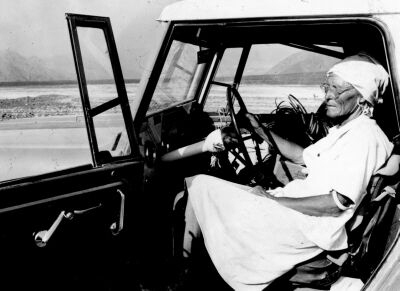
Maria Reiche in the car in the desert plain, in the 1970s
about
Just 2 km farther at km 422 of Southern Panamericana [21]
there is a natural viewing hill which is used by some
tourists to enjoy sunsets [27].
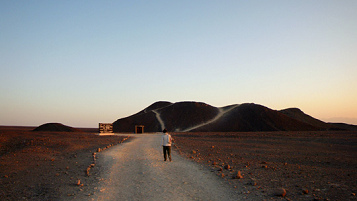
Viewing hill at km 422 of Southern Panamericana
|
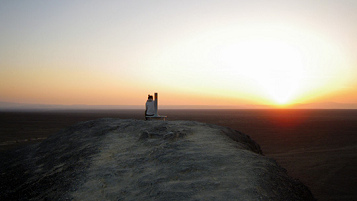
Viewing hill at km 422 of Southern Panamericana
with sunset over the Nasca plain
|
1977: Decoration of the
government of the republic "COMENDADOR" (Engl. Commander)
for Maria Reiche
(p.21)
April 1977: Maria Reiche
gives tourist information in the tourist hotel
Maria Reiche:
<Thanks to the courtesy of the director of all hotels of
Peru I could take a first class room to give informations to
tourists about the drawings who had taken a flight over the
drawings. This was in April 1977.> (p.16)
The manager of the ex tourist hotel was Ginger Dianderas.
There are rumours that when the manager was changing Maria
suffered a lot and this had been one of the few times when
Maria Reiche was loosing tears (p.16).
[It seems that the new manager never had seen the lines, and
machismo and arrogance of Peruvians to foreigners has no
limits, and this is also like this today in 2009. This
exists in all levels, managers, "house wifes", artisans,
taxi drivers etc.]
1978: Nasca territory is
declared protected zone
In 1978 Maria Reiche could effect that the Nasca region with
it's lines was declared a protected zone [2].
November 1978: Visit by
queen Sofia from Spain
In November 1978 it was Maria Reiche's success to show the
drawings of Nasca to queen Sofie from Spain [20].
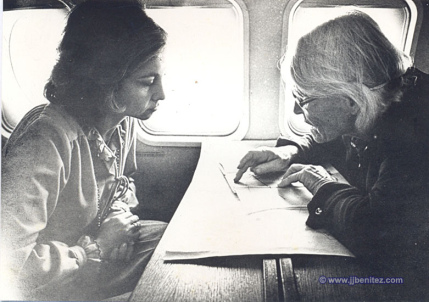
Maria Reiche in November 1978 with queen Sofia
from Spain
(from: www.planetabenitez.com/80mundo/nasca.htm)
|
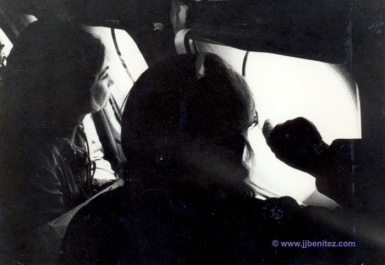
Maria Reiche in November 1978 with queen Sofia
from Spain in a flying little airplane showing the
drawings
|
1979: Biography from
Clorinda Caller Iberico about Maria Reiche
In 1979 Clorinda Caller Iberico edited one of the most
beautiful biographies about Maria Reiche with the title
"Maria Reiche y los Dioses de Nasca" ["Maria Reiche and the
gods of Nasca"] (p.9).
1980s
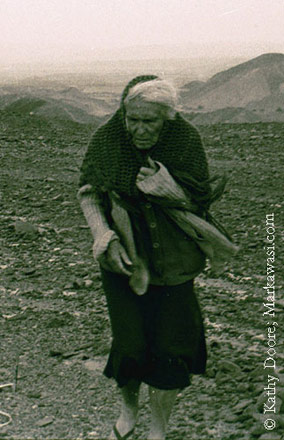
Maria Reiche in the desert plain in winter
clothes, in the 1980s about
|
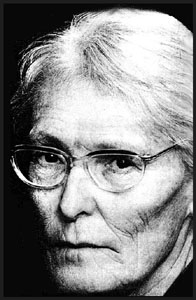
Maria Reiche, portrait of the 1980s about
|
1981: Decoration of the
Congress of the Republic "Great Official" ("Gran Oficial")
for Maria Reiche
(p.21)
1981: First public birthday
celebrations for Maria Reiche
In 1981 it was the first time that for Maria Reiche were
organized public birthday celebrations in Nasca, for her
78th birthday. Initiator was the mayer Aroldo Corzu Catalán
(p.17).
Since 1981 the name "Maria Reiche" also is used for public
Peruvian institutions. The beginning was a schooling
institution "Education Center" ("Centro Educativo") Nr.
22401, a part of the NEC Nr. 3 of Nasca, with the name
"Maria Reiche Neumann". The denomination had taken place on
the base of the regional manager's resolution No. 01069,
taken by the regional Education Department ("Dirección
Regional de Educación"), from 11 September 1981 (p.20).
1983: Maria Reiche
receiving Federal Cross of Merit First Class of Federal
German Republic
[1, 2]
1983: Maria Reiche
receiving honorary doctorate of Ica University
[2]
15 May 1983: Maria Reiche
Alley inaugurated in Nasca
[17]
|
On 15 May 1983
Lion's Club of Nasca opened a Maria Reiche Alley
[17]
|
And soon at
Maria Reiche Alley there was installed also a
statue. In the background can be seen the
steeple of the church of Nasca at Main Square
(Plaza Mayor, Plaza de Armas) [17]
|
16 September 1983: Pension
for Maria Reiche
Since 1983 Maria Reiche gets a state's pension ("pensión de
gracia"). The resolution is taken by government of Fernando
Belaunde Terry by the resolution no. 23674 from 16 September
1983. She gets 4 minimal salaries (p.20).
1984: Arrival and help from
sister Renate Reiche
In 1984 sister Renate Reiche arrived at Nasca and helped
Maria Reiche at work to mediate the message of the geoglyphs
of Nasca to the world. Until today Renate is hardly
mentioned. Renate's financial means were a help to beware
the geoglyphs (p.11).
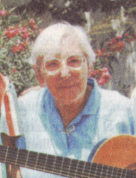
Renate Reiche-Grosse, portrait with guitar |
![Maria Reiche in 1984, she could only walk
with two walking sticks [17]. Parkinson was
coming [15] which is caused by amalgam, that's
proved [31]. Maria Reiche in
1984, she could only walk with two walking
sticks [17]. Parkinson was coming [15] which is
caused by amalgam, that's proved [31].](d/Munoz_Reiche-d/48-Maria-Reiche-1984-c-bastones.jpg)
Maria Reiche in 1984, she could only walk with two
walking sticks [17]. Parkinson was coming [15]
which is caused by amalgam, that's proved [31].
|
1986:
Award "AMAUTA" for Maria Reiche, given by the Ministry of
Education
(p.21) resp. award with the decoration of "Las Palmas
Magisteriales" of the grade of "Amauta" [2].
Decoration of the wise of
the Inkas for Maria Reiche, given by the President Alán
García Pérez [2]
Honorary Doctorate of San
Marcos University of Peru for Maria Reiche [2]

Maria Reiche in 1986 with 83 years, portrait with desert
plain in the background
Now the sister Renate Reiche was taking over the lectures
about the Nasca lines which had been given by Maria Reiche
up to this time [4: Daeniken, p.52].
1986 about? Poem about the
bold bird Peruvian Thick-knee (Huerequeque)
Mrs. Reiche wrote a poem about the bold bird Peruvian
Thick-knee (Span.: Huerequeque) thinking on her future after
her death: People, especially her sister Renate from
Germany, should stay on this spot and everybody should be a
Peruvian Thick-knee and to bother about her sister and
her property (p.18). Maria Reiche wrote the poem and the
brothers Willy and Tito Rojas wrote the Huayno music for it
(a typical Andes dance music) (p.19).
Translated into
English by Michael Palomino:
Peruvian
Thick-knee (Burhinus superciliaris) |
(orig. Spanish:
El Huerequeque
(Burhinus superciliaris) |
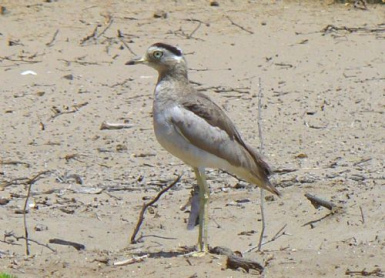
|
During sunrise
Peruvian Thick-knee is awaking
and with his singing he brightens up all the East
and announces the Sun's loveliness
which will give light far and wide
and will cover the mountains with it's gold
as also the plains as far as they go
is shining the ray of the Sun
until they waves in the wide sea.
And when evening is coming with it's dark and
profound night
and with the stars and the multi coloured lights
so Peruvian Thick-knee will sing again
saying Hello to the stars
which give their light through the golden clouds
with a blue sky in the background
where the desert ends.
Peruvian Thick-knee, Peruvian Thick-knee
he will guard my plains
Peruvian Thick-knee, Peruvian Thick-knee
he will sing for Renata
Peruvian Thick-knee, Peruvian Thick-knee
he will sing for Pilhips
Peruvian Thick-knee, Peruvian Thick-knee
he will give pleasure to my days. (p.19)
|
Amaneciendo,
despierta el huerequeque
Y con su canto, ilumina todo el este
Anunciando el esplendor
Del astro rey que alumbra
Y que cubre de oro los cerros
Y también a las planicies
Se ve una vía luminosa
Sobre las olas del mar.
Y cuando cae, la noche obscura y profunda
Entre destellos, de luces multicolores
Vuelve a cantar en la pampa el huerequeque
Saludando a la estrella
Que brillan entre nubes de oro
Sobre un fondo azulado
Donde termina el desierto.
Huerequeque, huerequeque
Sigue cuidando mis pampas
Huerequeque, huerequeque
Sigue cantando a Renata
Huerequeque, huerequeque
Sigue cantándole a Pilhips
Huerequeque, huerequeque
Sigue alegrando mis días. (p.19)
|
|
|
6 July 1987: Installation
of the "Maria Reiche-Grosse Newmann" Association
At 6 July 1987 at 11 o'clock in the morning "Maria
Reiche-Grosse Newmann" Association was founded in the
locality of the former tourist hotel. It's purpose should be
to protect the geoglyphs of and around Nasca without view to
profit. This wanted Maria Reiche. The founders were
-- Mrs. Dr. Maria Reiche-Grosse Newmann
-- Mrs. Dr. Gabriele Von Gaisberg
-- the lady ("La Dama"), Elena Graffon
-- further persons (p.25).
At the first board meeting the following persons were
present:
President: Victoria Maria Reiche-Grosse Newmann
Vice President: Ing. James Martin Birkegk
Secretary: Frau Dr. Phylls Burton
Vice Secretary: Frau Gabriele von Gaisberg
Treasurer: Frau Renate Reiche-Grosse Newmann
Vice Treasurer: Dr. Linton Pitluga
Speaker: Ing. Moisés Velarde Santa María (p.25).
Maria Reiche 40 years after
1946 about their work: The ship passing the rain bows -
she had an introvert education
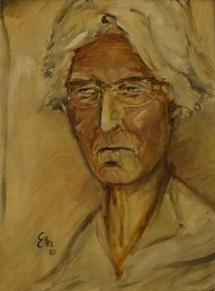
Painted portrait of Maria Reiche of the 1980s about
<It was a kind of destiny. When I first came to Peru by
sea the ship went passing through the center of four
consecutive rainbows, four arcs, one inside the other! It
was a marvelous spectacle. It must have been some kind of
prediction or something. Imagine a boat, a boat driving
through the open sea, passing through arching rainbows that
touched the waves.
Everything had prepared me for this life.
The isolation into which I found myself, my parents
putting me aside after my brother was born, my
shortsightedness not being detected, all made me an
introvert. It made me aloof because I was never the
popular type. Now the tourists have made me popular. I was
never popular! I sometimes wanted to be, but I could never
be. What compelled me on this quest was my curiosity - I
wanted to know!> [7]
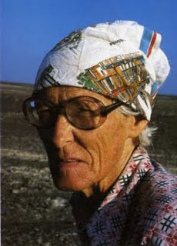
Maria Reiche in the late 1980s about, portrait with a
coloured cloth
(p.21)
1990s: Maria Reiche in the
wheel chair - and work is going on
<Also when she was in the wheel chair this was not an
obstacle for her to go on with her studies up to the old
age.> [1]
(orig. German:
<Selbst der Rollstuhl hinderte sie nicht, ihre Studien
bis ins hohe Alter fortzuführen.> [1])
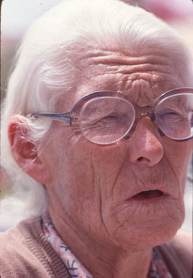
Maria Reiche, portrait, 1990s about
Since 1990 Maria Reiche was taken by air to Ronquillo one
time a week to relax in the hot springs of Ronquillo. The
sister Dr. Renate Reiche had a treaty for this with the
caretaker Edmundo Olivera Lucas (p.18).
since 1990 about: Life in
the hotel Nasca Lines Hotel in Nasca itself
The last years Maria Reiche lived in Nasca in the hotel
Nasca Lines Hotel with swimming pool and not any more in the
desert [26].
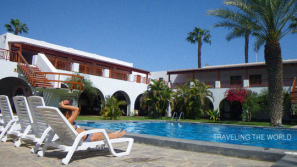
Nasca Lines Hotel in Nasca
Maria Reiche would reach soon 90 years when she - the "Lady
of the desert" - got the Peruvian passport, in recognition
of the hard research work which had saved the Nasca plain
(p.18).
![Maria Reiche, in 1992
about. Their last years she was with amalgam illness
Parkinson in the wheel chair. Left the caretaker
Francisco Cantoral, right Ana María Cogorno, holding
books of Maria Reiche in their hands [15]. Maria Reiche, in 1992 about. Their
last years she was with amalgam illness Parkinson in the
wheel chair. Left the caretaker Francisco Cantoral,
right Ana María Cogorno, holding books of Maria Reiche
in their hands [15].](d/Munoz_Reiche-d/54-Maria-Reiche-1992apr-en-silla-de-ruedas.jpg)
Maria Reiche, in 1992 about. Their last years she was with
amalgam illness Parkinson in the wheel chair. Left the
caretaker Francisco Cantoral, right Ana María Cogorno,
holding books of Maria Reiche in their hands [15].
(p.21)
1994: Arrival of girlfriend
Eva Pehlemann
(S.17)
17 December 1994: The Nasca
lines are declared heredity of UNESCO
The lines in the plains of Jumana and San José were declared
for world heredity of UNESCO (p.24). Maria Reiche gets the
UNESCO certificate for the enrollment of the geoglyphs and
lines of the Pampa of Nasca as "Monument of Human Heredity"
[2] with the signature (K/1994) [3].
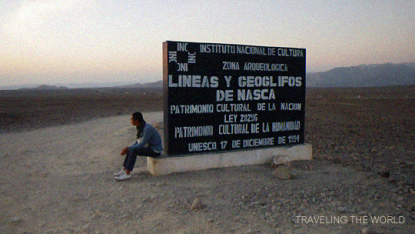
The information board of the Nasca plains after the UNESCO
resolution of 17 December 1994 to call the Nasca lines
World Cultural Heritage
On 2 February 1995 Maria Reiche adopted Ana Maria Cogorno
Mendoza as adoptive daughter (p.25).
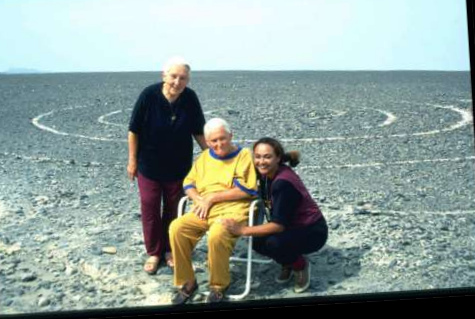
Maria Reiche (center) short time before her death (in 1995
about, about 92 years old) with sister Renate (left) and
Ana Maria, adoptive daughter
Maria Reiche said from herself about her work in Nasca:
<The gods of Nasca themselves have taken me from the
beginning to their sand castle and have locked me up there
to play with their giant drawings until I found the base of
my existence one day.> (orig.: <Ya los Dioses de Nasca
me robaron al nacer y me encerraron en su castillo de arena
para que jugara con sus inmensas figuras, hasta encontrar un
día la razón de mi existencia>). (p.9)
<I decided that my life will be in Nasca up to the last
minute of my life. There will be only little time for this
treasure which is in this plain. Here I will die.>
(span.: <Tengo definida mi vida hasta el último minuto de
mi existencia; será para Nasca. El tiempo será poco para
estudiar la maravilla que encierran las Pampas: allí
moriré.>) (p.16)
Where is love?
Maria Reiche avowed that she was with passion in love with
one of her pupils with 40 years, but she never said it's
name. But she said he had red hair and freckles. According
to her girlfriend Clorinda Caller it was a young Jew
with poliomyelitis. He could speak some languages and add to
this was translator at UN (p.16).
Statements of sister Renate
about Nasca
Sister Renate said about Nasca: "All what I have done has
been for this plain, for Maria and for Peru" (orig.: "Todo
ha sido por la pampa, para María y para el Perú") (p.11).
1996: Strong earthquake in
Nasca - the whole town is in rubble
The earthquake was during the day. By this there were only a
few fatalities [19].
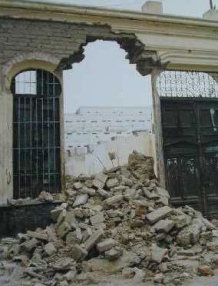
Earthquake damage in Nasca 1996 (01): The whole
house is a pile of clay bricks
|
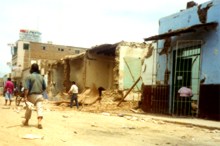
Earthquake
damage in Nasca 1996 (02): In this street mainly
the fronts are destructed. The side walls
without doors and without windows are staying
yet.
|
|
|
Reconstruction of Nasca:
Quakeproof constructioning with columns in concrete -
women included
After the earthquake of 1996 Nasca was reconstructed
completely within 10 years, with decisive measures:
-- all houses had to be built in modern, burnt bricks, and
with quakeproof columns in concrete [19]
-- the women got schooling in house constructioning to be
part of the working force for the reconstruction [32].
1996 appr.: Death of sister
Renate Reiche by a liver disease
The younger sister dies first [4: Daeniken, p.52].
31 July 1997: Nullification
of the adoption
On 31 July 1997 the Supreme Court (orig.: "Corte Superior")
declares the nullification for the adoption of Ana María
Cogorno Mendoza (p.25). It's not possible to adopt an adult
person [6].
8 June 1998: Death of Maria
Reiche - Pilhips Pitluga should continue the research
Maria Reiche, the "Lady of the desert" (orig.: "La dama de
las Pampas") died with 95 years on 10:41 in the morning
(p.20). She died of ovarian cancer [33]. Maria Reiche died
happily because she knew that researcher Pilhips Pitluga
(North "American") would go on with it's research work
(p.21).
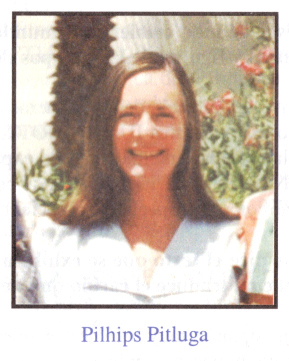
Pilhips Pitluga, portrait, she should continue with the
research on the Nasca lines after the death of Maria
Reiche
The corporal remainings were housed in the mausoleum besides
the Maria Reiche Museum at km 417 of southern Panamericana
in hamlet Pascana of San Pablo in El Ingenio district, 27 km
from Nasca, together with the ashes of sister Renate (p.20).
Maria
Reiche Museum
also shortly called MR museum ("Museo MR") [28] |
|
Maria Reiche in
1977 before the garden wall in San Pablo in
Ingenio district
|
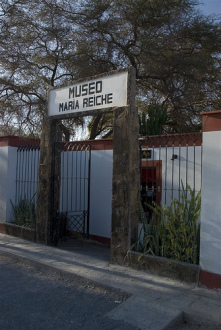
The entrance was remodeled and is the entrance of
Maria Reiche Museum of today
|
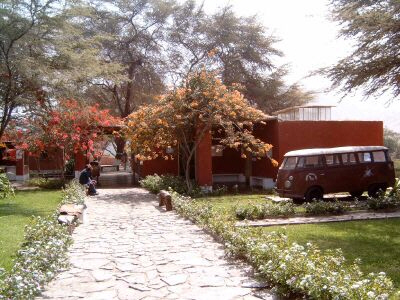
The little house
behind the walls was converted into Maria Reiche
Museum
|
The room of
Maria Reiche is yet in this order as it had been
left, a part of the Maria Reiche museum, where
Maria Reiche is represented writing on her desk,
surrounded with many plans and a German honoured
flag. The papers were left as they were at her
death. This is all unfinished research... [15]
|
|
Maria Reiche
museum, the Volkswagen VW bus used by her
|
|
The text at the entry of
the Maria Reiche museum
<It would be a very weak idea to admit that the great and
precise work performed with a diligent perfection would give
only the result that here would be presented only a
primitive superstition or a sterile cult of the ancestors.
At the contrary here is presented a testimony in a big style
and singular in the world from the first awake of the exact
sciences of the evolution of Mankind. It's a giant product
of primitive spirit that presents itself in it's giant
dimensions under the naked sky in a giant and isolated
plain, always cleaned by the wind and burnt by the Sun.>
(orig. span.: <Sería tener una opinión muy baja de los
antepasados suponer que todo este trabajo inmenso y
minuciosamente exacto y detallado hecho con concienzuda
perfección, tenía como única finalidad el servicio de una
superstición primitiva o culto estéril al los antepasados.
Al contrario tenemos aquí el testimonio en gran escala y
único en el mundo del primer despertar de las ciencias
exactas en la evolución de la humanidad, esfuerzo gigantesco
de la mente primitiva que se refleja en la grandeza de la
ejecución bajo el cielo vasto de las Pampas inmensas y
solitarias, barridas por el viento y quemadas por el
sol.> (p.22))
9 June 1998 (posthum):
Verdienstorden ("Orden al Mérito") "GRAN CRUZ"
("Grosses Kreuz") for Maria Reiche
by President of Congress ("Presidente del Consejo de
Ministros") Javier Valle Riestra (p.22)
since 9 June 1998: Block of
research: the researcher Pitluga capitulating before the
Maria Reiche Association of Ana Maria Cogorno Mendoza
Further research on Nasca lines by researcher Pilhips
Pitluga was blocked by the pseudo association "Maria Reiche"
from pseudo adoptive daughter Ana Maria Cogorno Mendoza.
Pitluga left Nasca (p.21).
October 2005: Inauguration
of Maria Reiche Street in Dresden Klotzsche
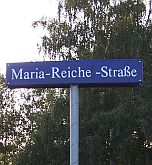
In October 2005 the "Dr. Maria Reiche" Association (orig.:
Verein "Dr. Maria Reiche") inaugurated a Maria Reiche
Street in Dresden Klotzsche [23].
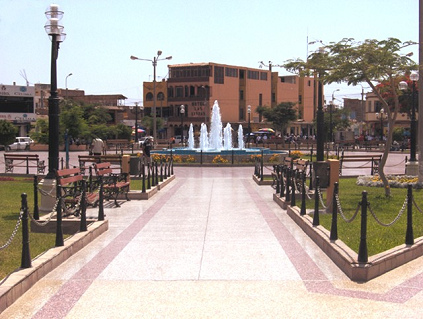
Reconstructed Nasca, Main Square (Plaza Mayor, Plaza de
Armas), in 2008 about
One of the latest honors for Maria Reiche (about in 2008) is
Maria Reiche Park in Miraflores in Lima just aside the Love
Park ("parque de los enamorados"). Some of the Nasca
drawings are implanted with earth lines and flowers into the
lawn [17].
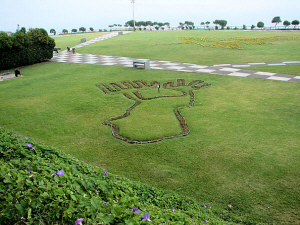
Maria Reiche
Park in Miraflores in Lima, the drawing of the
hands with only 9 fingers
|
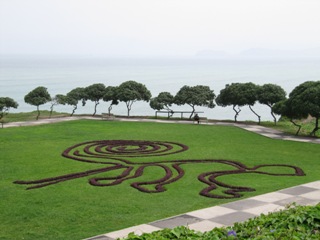
Maria Reiche Park in Miraflores in Lima, the
drawing of the monkey with only 9 fingers |
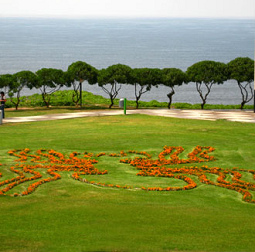
Maria Reiche Park in Miraflores in Lima, the
drawing of the spider
|
Maria Reiche
Park in Miraflores in Lima, the drawing of the
hummingbird with a children's play ground with
artificial lawn aside, what an exemplary play
ground!
|
At the same time one can see that there are needed contrast
colored flowers to make visible the drawings on a green lawn
[6].
Result
<Maria Reiche detected and measured about 50 geoglyphs
(drawings) and 100 lines in the Nasca plain.> [1]
(orig. German:
<Maria Reiche hat etwa 50 Figuren und 1000 Linien in der
Pampa von Nasca entdeckt und vermessen.> [1])
<About 800 lines on a surface of about 120 squared
kilometers were measured by her by the theodolite.> [30]
(orig. German:
<Etwa 800 Linien auf einer Fläche von etwa 120
Quadratkilometern wurden durch sie mit den Theodoliten
vermessen.> [30])
Honors for Maria Reiche
among others
-- 1977: Decoration of the Government of the Republic
"COMENDADOR" (Engl.: "Commander")
-- 1981: Decoration of the Congress of the Republic "GRAN
OFICIAL"
-- 1986: award "AMAUTA", given by the Education Department
-- 1990: Decoration "GRAN CONTRALOR", given by General
Accounting Office of the Republic
-- 1993: Decoration "SOL" (Engl.: "Sun") with the grade of
the "Big Cross" (p.21), one of the highest awards of
Peruvian Republic, the decoration of the sun [1]
-- 1998 (posthumously): Order of Merit "GRAN CRUZ" ("Big
Cross"), given by Congress President ("Presidente del
Consejo de Ministros"), Javier Valle Riestra (p.22).
Add to this Maria Reiche was given
-- Federal Cross of Merit of First Class of German Federal
Republic [1] in 1983 [2]
-- decoration of the Wises of the Inkas [1]
-- title of honorary doctor of Peruvian San Marcos
University [1]
-- all in all she got five honorary doctorates [1]
-- honorary doctorate of Ica University 1983 [2].
Works of Maria Reiche
-- "Giant soil drawing in the plains of Nasca and Palpa.
Description and trial of an interpretation" (span.: "Los
Dibujos Gigantescos en el suelo de las Pampas de Nasca y
Palpa. Descripción y ensayo de interpretación"); Médica
Edition ("Editora Médica"), Jirón Azángaro 906, Lima, 1948
(p.15)
-- "Prehistoric Ground Drawing In Peru"; Offiz Indruck A.G.,
Stuttgart 1955
-- "Secret of The Desert", 1968

-- "The bird calling for Inti Raymi festival" (Span.: "El
pájaro Anunciador del Inti Raymi")
-- "Contributions in geometry and astronomy in ancient Peru"
(span.: "Contribuciones a la Geometría y la Astronomía en el
Antiguo Perú")
all in self-publishing by Maria and Dr. Renate Reiche,
Stuttgart 1968 (p.15).
Books about Maria Reiche
and her work
-- biography about Maria Reiche by Clorinda Caller Iberico
1979
-- Richter, Christiane: Heredity of Maria Reiche; In: Peru
News, Special Review: The Coast (orig. German: Das Erbe der
Maria Reiche. In: Peru-Nachrichten, Themenheft: Die Costa);
Edited by Peru Office Heidelberg, archdiocese Freiburg
(orig. German: Perubüro Heidelberg, Erzdiözese Freiburg),
2004 [1]
-- Schulze, Dietrich / Zetzsche, Viola: Picture-book of the
desert. Maria Reiche and the soil drawings of Nasca (orig.
German: Bilderbuch der Wüste. Maria Reiche und die
Bodenzeichnungen von Nasca); Mitteldeutscher Verlag Halle,
Halle 2005, ISBN 3-89812-298-0 [1]



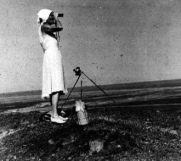
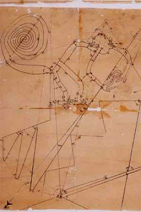
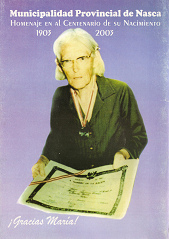
Booklet about Maria Reiche in celebration of her 100th anniversary in 2003
Pedro Cieza de León, here is a print of one of his reports about the "Indians" (natives),



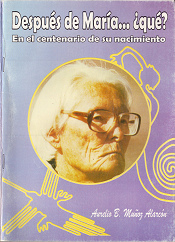



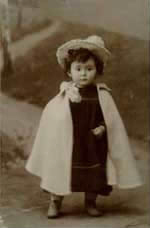
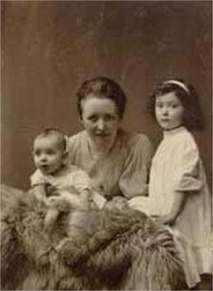
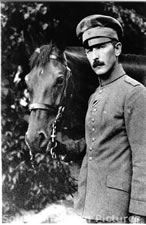
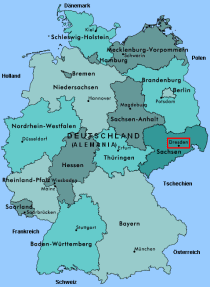




![Maria Reiche in the 1930s about in Peru,
portrait. Her shortsightedness was detected only in
Peru, and since then she was wearer of glasses [7]. Maria Reiche in the 1930s about in
Peru, portrait. Her shortsightedness was detected only
in Peru, and since then she was wearer of glasses [7].](d/Munoz_Reiche-d/13-Maria-Reiche-1930s-apr-retrato.jpg)






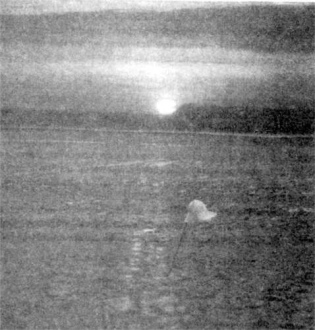




![Maria Reiche in the 1960s
with a Volkswagen (VW Beatle) and broom to clean
the lines. The old Volkswagen was bought by
sister Renate for Maria [18]. Maria Reiche in the 1960s with a Volkswagen
(VW Beatle) and broom to clean the lines. The
old Volkswagen was bought by sister Renate for
Maria [18].](d/Munoz_Reiche-d/23-Maria-Reiche-1960s-c-volkswagen-en-desierto.jpg)
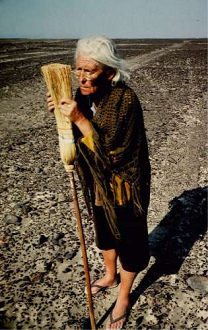
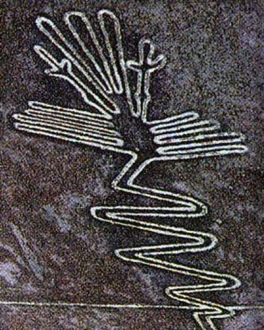


![Maria Reiche about in the
1960s measuring a line here. This photo became
world-famous and changed the awareness of the
world [15] Maria Reiche about
in the 1960s measuring a line here. This photo
became world-famous and changed the awareness of
the world [15]](d/Munoz_Reiche-d/28-Maria-Reiche-1960s-apr-midiendo-Linea.jpg)


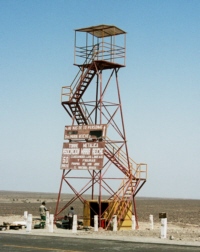

![Der
Aussichtsturm hat sogar eine Ortstafel
bekommen [24], denn scheinbar ist der Turm so
unscheinbar, dass viele daran vorbeigefahren
sind [6]. Der Aussichtsturm hat sogar eine
Ortstafel bekommen [24], denn scheinbar ist
der Turm so unscheinbar, dass viele daran
vorbeigefahren sind [6].](d/Munoz_Reiche-d/34-mirador-metalico-c-placa-mirador.jpg)
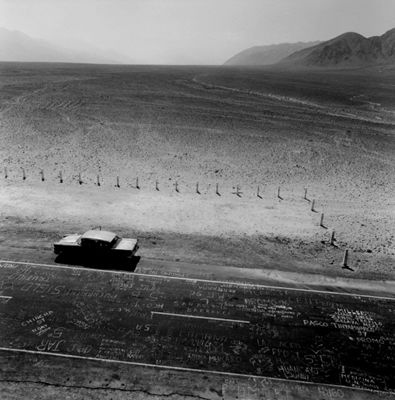
![The
viewing tower is located just aside the drawings of the
lizard, the tree, and the hands (with 9 fingers as the
monkey). There can be seen on the photo that the lizard
was parted by the Panamericana at the begin of it's
tail. The wheel tracks of "wild visitors" in
the background have already caused considerable damage
[25]. The viewing tower is located just
aside the drawings of the lizard, the tree, and the
hands (with 9 fingers as the monkey). There can be seen
on the photo that the lizard was parted by the
Panamericana at the begin of it's tail. The wheel tracks
of "wild visitors" in the background have
already caused considerable damage [25].](d/Munoz_Reiche-d/36-mirador-metalico-c-pintados-Lagarto-arbol-manos.jpg)







![On 15 May 1983
Lion's Club of Nasca opened a Maria Reiche
Alley [17] On
15 May 1983 Lion's Club of Nasca opened a
Maria Reiche Alley [17]](d/Munoz_Reiche-d/45-Maria-Reiche-avenida-Nasca-1983.jpg)
![And soon at Maria Reiche Alley there
was installed also a statue. In the background
can be seen the steeple of the church of Nasca
at Main Square (Plaza Mayor, Plaza de Armas)
[17] And
soon at Maria Reiche Alley there was installed
also a statue. In the background can be seen
the steeple of the church of Nasca at Main
Square (Plaza Mayor, Plaza de Armas) [17]](d/Munoz_Reiche-d/46-Maria-Reiche-estatua-Nasca.jpg)

![Maria Reiche in 1984, she could only walk
with two walking sticks [17]. Parkinson was
coming [15] which is caused by amalgam, that's
proved [31]. Maria Reiche in
1984, she could only walk with two walking
sticks [17]. Parkinson was coming [15] which is
caused by amalgam, that's proved [31].](d/Munoz_Reiche-d/48-Maria-Reiche-1984-c-bastones.jpg)






![Maria Reiche, in 1992
about. Their last years she was with amalgam illness
Parkinson in the wheel chair. Left the caretaker
Francisco Cantoral, right Ana María Cogorno, holding
books of Maria Reiche in their hands [15]. Maria Reiche, in 1992 about. Their
last years she was with amalgam illness Parkinson in the
wheel chair. Left the caretaker Francisco Cantoral,
right Ana María Cogorno, holding books of Maria Reiche
in their hands [15].](d/Munoz_Reiche-d/54-Maria-Reiche-1992apr-en-silla-de-ruedas.jpg)





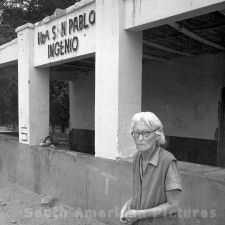


![The
room of Maria Reiche is yet in this order as
it had been left, a part of the Maria Reiche
museum, where Maria Reiche is represented
writing on her desk, surrounded with many
plans and a German honoured flag. The papers
were left as they were at her death. This is
all unfinished research... [15] The
room of Maria Reiche is yet in this order as
it had been left, a part of the Maria Reiche
museum, where Maria Reiche is represented
writing on her desk, surrounded with many
plans and a German honoured flag. The papers
were left as they were at her death. This is
all unfinished research... [15]](d/Munoz_Reiche-d/60-Maria-Reiche-museo-cuarto-c-escritorio.jpg)
